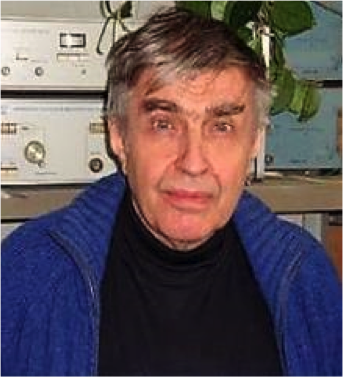
Andrey K. Lyashchenko
Dr. of Sciences (Chemistry), Professor
- Dielectric spectroscopy and radio brightness parameters of water systems on cm and mm waves.
- Structure of aqueous solutions of electrolytes, non-electrolytes, and polyelectrolytes. Study of hydrated (solvate) complexes and aggregates in different concentration areas according to experimental methods, quantum-chemical calculations, theory of dielectrics, and computer simulation using the molecular dynamics and Monte Carlo methods.
- Relationship of the dielectric and structural-kinetic changes of water in solutions with their macroscopic properties, homogeneous, heterogeneous equilibria, phase separation processes, crystal growth, and production of materials.
A new structural-kinetic model of water explaining water spectra in cm, mm, and submm regions was developed; the mechanism of hydrophobic hydration was created. A new remote method was developed to study the properties of water and solutions by their radio brightness characteristics in mm area. During microwave dielectric investigation of 30 solutions of non-electrolytes and electrolytes in the cm and mm ranges and in the temperature range, previously unknown patterns of hydrated water changes over short times (10–11 s) were established. Static dielectric constants of concentrated salt solutions were found. A method to determine the structure of solvate complexes in solution (according to IR spectroscopy and quantum chemistry) was suggested, and the structural and energy criteria common to aqueous and non-aqueous systems which correspond to stable heteroassociates were determined. New coordinates determined by dielectric properties were introduced into the physicochemical analysis of water-salt systems. An extended non-empirical Debye–Hückel theory to calculate the activity coefficients of ions and water in a wide concentration range, taking into account the experimental static dielectric constants of solutions, was suggested.
- Irina V. Balakaeva Senior Researcher, Ph.D. (Chemistry)
- Victor S. Dunyashev Head Technologist
- Elena G. Tarakanova Senior Researcher, Ph.D. (Physics and Mathematics)
Postgraduate students
Aleksey Yu. Efimov
- K. Lyashchenko, T.A. Novskova. Structural dynamics and orientational polarization spectra of water and other liquids. The chapter in monograph “Structural self-organization in solutions and at the interface”. Ed. by A.Yu. Tsivadze. Moscow: LKI, 2008. Chapter 7, p. 417–500. [in Russian]
- K. Lyashchenko, A.S. Lileev. Dielectric relaxation of water in hydration shells of ions // Journal of Chemical & Engineering Data. 2010. V. 55. p. 2008–2016.
- Y. Zasetsky, A.S. Lileev, A.K. Lyashchenko. Molecular dynamic simulation of terahertz spectra for water-methanol mixtures // Molecular Physics. 2010. V. 108(5). p. 649–656.
- Y. Zasetsky, A.K. Lyashchenko, A.S. Lileev. Ion-ion and ion-water aggregation and dielectric response of aqueous solutions of Li2SO4: molecular dynamic simulation study // Molecular Physics. 2011. V. 109 (6). p. 813–822.
- V. Balakaeva, A.K. Lyashchenko. Transition to glassy solutions in the Y(HCOO)3–Ba(HCOO)2–Cu(HCOO)2–H2O quaternary system proceeding from microwave dielectric data // Russian Journal of Inorganic Chemistry. 2016. V. 61(10). p. 1307–1311.
- Y. Shilov, A.K. Lyashchenko. The role of concentration dependent static permittivity of electrolyte solutions in Debye-Huckel theory // Journal of Physical Chemistry B. 2015. V. 119. p. 10087–10095.
- K. Lyashchenko, V. S. Dunyashev, A.Yu. Zasetsky. Effects of concentration on the microwave dielectric spectra of aqueous urea solutions // Russian Journal of Physical Chemistry A. 2017. V. 91(5). p. 887–893.
- G. Tarakanova, G.V. Yukhnevich. Composition and structure of hydrates of CH3COOH molecules and CH3CO2−anions in aqueous solutions // Journal of Structural Chemistry. 2017. V. 58(7). p. 1357–1367.
- K. Lyashchenko, I.M. Karataeva. Radiation of multicomponent aqueous salt solutions in the millimeter-wave spectral region // Russian Journal of Inorganic Chemistry. 2017. V. 62(1). p. 128–130.
- Y. Shilov, A.K. Lyashchenko. Modeling activity coefficient in alkali iodide aqueous solutions using the extended Debye–Huckel theory // Journal of Molecular Liquids. 2017. V. 240. p. 172–178.
- K. Lyashchenko – Certificate of Honor from IGIC RAS for fruitful scientific work and valuable contribution to the development of modern chemical science (2013)
Grants of the Russian Foundation for Basic Research
- 16-03-00725. Structural-kinetic and dielectric changes in solutions of electrolytes and non-electrolytes in the field of high concentrations and heterogeneous equilibrium of water-salt systems (2016–2018)
- 12-03-00062. Temperature dependence of microwave dielectric properties and structural-kinetic changes of water in electrolyte solutions with hydrophobic and hydrophilic hydration (2012–2014)
- 08-03-00095. Structural-kinetic changes, static dielectric constant, and thermodynamic activity of water in two- and multicomponent water-electrolyte systems (2008–2010)
Projects in basic research programs of the Presidium of the Russian Academy of Sciences
- Radio brightness contrasts of water-electrolyte and water-non-electrolyte systems in the gigahertz and terahertz regions (2015–2017)
- Effect of directed structural-kinetic changes of water in solutions on ionic aggregation, formation of nanoparticles, and preparation of materials based on them (2012–2014)
- Remote method for monitoring and determining concentration of aqueous solutions according to their radio brightness characteristics in mm spectrum range (2012–2014)
- Dielectric spectroscopy as method to analyze structural-kinetic properties and concentrations of water in solutions and complex aqueous systems (2009–2011)
- Structural-kinetic changes of water in solutions and their effect on substance separation, preparation of materials, and crystal growth (2009–2011)
- Shubnikov Institute of Crystallography RAS (Moscow)
- Baykov Institute of Metallurgy and Materials RAS (Moscow)
- Topchiev Institute of Petrochemical Synthesis RAS (Moscow)
- Kotelnikov Institute of Radioengineering and Electronics RAS (Moscow)
- Semenov Institute of Chemical Physics RAS (Moscow)
- Moscow State University (Moscow)